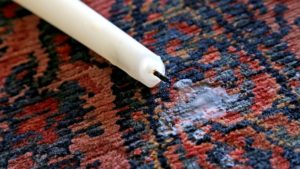Area Rug Cleaning – Basic Rug Care, Corona, CA
Area Rug Cleaning – Basic Rug Care, Corona, CA
Rug care is determined by size, construction, and material.  Care for large-size area rugs as you would wall-to-wall carpet.
Care for large-size area rugs as you would wall-to-wall carpet.
Vacuum large rugs to remove dirt. As with carpet, the most important thing you can do for larger area rugs is to vacuum them regularly. If a rug is reversible, vacuum both sides. This removes grit and grime that can wear out your rug prematurely. Take care to not vacuum the fringe of your rug.
Brush out pet hair. A vacuum will sometimes leave pet hair behind. Use a stiff brush to remove the hair, brushing in the direction of the nap of the rug.
Turn rugs every year. Foot traffic and sun can put extra stress on area rugs. Turn them once or twice a year to even out the wear.
Shake small area rugs. If the rug is small enough, you can take it outside and shake it or beat it vigorously to remove dirt and grit. Some areas have ordinances about shaking rugs outdoors, so check your local codes.
Special types of rugs require special cleaning care. Keeping care tags on the rug or in a file can save you from costly mistakes. Follow these tips for taking care of specialty rugs.
- Woven or braided rugs: Check rugs for stitching breaks before and after cleaning. Check labels to determine whether small braided rugs are washable. If they are, place them in a zippered pillowcase or mesh laundry bag. Wash in cool water on a gentle cycle, rinsing thoroughly. Tumble dry on a low setting. Place large braided rugs on a vinyl or concrete floor or place an old blanket beneath them. Sponge commercial carpet-cleaning foam over the surface and rub it in according to the product directions. Finish by rinsing or vacuuming. Dry thoroughly before replacing the rug on the floor.
- Handmade, hand-knotted, antique, and Oriental rugs: Vacuum a new Oriental rug as you would carpet and wool area rugs. Use special care with delicate vintage or antique rugs. Protect them from the vacuum by placing a piece of nylon screen over the rug and weighting it down with books or bricks. Vacuum over the screen. Or, tie a piece of nylon mesh over the vacuum attachment and change the mesh frequently as dirt accumulates. Have these rugs professionally cleaned once a year. Rotate rugs to ensure even wear; direct exposure to sun will cause fading.
Note: When buying antique rugs, learn as much as you can from the seller about the rug’s fiber content and construction. Ask for care tips. - Coir, sisal, rush, and grass rugs: Rugs made from these natural fibers feature an open weave that allows dirt to sift through to the floor beneath. Vacuum frequently, removing the rug occasionally to vacuum the floor, as well. Many of these rugs are reversible; if so, flip every time you vacuum for even wear.
To clean stains or discolorations on a room-size natural-fiber rug, leave it in place. Protect the floor beneath it with a plastic drop cloth and towel. Scrub the stains with a soft brush dipped in soapy water. Rinse with clear water. Place a towel over the wet area. Blot the cleaned spot as dry as possible. Use a portable fan or hair dryer to speed drying. Move small rugs to a protected table or counter to clean. Water weakens the fibers, so work quickly and dry thoroughly to extend the life of these rugs.
Some natural-fiber rugs are constructed in squares that are sewn together. Buy a few extra squares or a smaller size of the same rug. If a rug square becomes irrevocably stained, clip the threads that hold it in place and replace with a new square. Hand-stitch it in place with heavy-duty carpet thread. - Fur, sheepskin, and hair-on hides: Shake unscented talcum powder on fur, sheepskin, and hair-on hide rugs and leave for several hours. Brush the talcum powder through the hair, then shake it out. Repeat this process several times, depending on the length of the fur.
To clean the back of such a rug, use a clean cotton cloth dipped in lukewarm soapy water. Wipe off any dirt or spills. Rinse with a cloth dipped in clean water and allow to dry completely before putting back in place.
About Deep Cleaning
Washing and drying small rugs. Consult care labels for small rugs to determine whether they should be dry-cleaned, spot-cleaned, or laundered. A dry-cleaning-only label might indicate that a rug is not colorfast. Test before spot-cleaning.
When you determine that a rug is washable, machine-wash it on the delicate cycle. To reduce the risk of tangling long fringe, divide the fringe into several hanks and wrap each one with white string. Place the rug in a mesh laundry bag or zippered pillowcase to protect it from the agitator, and wash in cold water on the gentle cycle.
Hang wet rugs over a clothes-drying rack, a slatted picnic table, or several bricks stacked on a porch, patio, or breezeway. Hanging a wet rug over a single clothesline will distort the shape of the rug as it dries. Small rugs made from synthetic fibers similar to carpeting can be laid to dry on a small worktable or counter that is protected by a drop cloth, old sheets, or towels.
Area rugs will benefit from a deep cleaning every 12″ -18 months. When using commercial cleaning products for the first time, test a small area of the rug to ensure that it is colorfast and not otherwise damaged by the product. To thoroughly clean a large rug, place it on a vinyl or concrete surface and apply carpet-cleaning foam and rub in according to directions. Finish by rinsing or vacuuming. Make sure the rug is dry before replacing it.
Dry-cleaning might also be an option for small- to mid-size rugs — check the labels for care instructions.
Stain-Removal Guide for Rugs
Time is of the essence when your rug becomes stained. Remember to blot — not rub — the stain and remove moisture from spills as quickly as possible.
- Alcohol and soft drinks: Use a solution of 1 teaspoon liquid dish detergent, 1 quart of warm water, and 1/4 teaspoon of white vinegar. Apply to the stain, rinse, then blot dry.
- Coffee or tea: Using the detergent mix above, apply to stain, rinse, and blot. If a stain remains, use a commercial spot carpet cleaner.
- Fat-based stains: For foods such as butter, margarine, or gravy, use a dry-solvent spot carpet cleaner.
- Gum: Peel off what you can, then put ice cubes in a plastic bag and harden the gum, scraping the gum off with a spoon or dull knife. Vacuum and use a dry-solvent spot cleaner if needed.
- Paint: For acrylic and latex paint, while the stain is still wet, spot-clean with the detergent solution. If color remains, dab with rubbing alcohol. For oil-base paint, sponge with odorless mineral spirits, being careful not to soak through to the backing.
- Tomato sauce: Sponge with cool water, dab with detergent solution or a citrus-oxygen cleaner. Rinse with a solution of 1 cup white vinegar and 2 cups of water and blot until dry.
- Urine, feces, and vomit: Apply detergent solution or a citrus-oxygen cleaner, rinse, and blot until dry.
- Melted wax: Use the same treatment as gum, hardening it with ice cubes in a plastic bag and scraping. Dampen a clean white cloth or cotton ball with rubbing alcohol and blot to remove any remaining wax.

Leave a Reply
Want to join the discussion?Feel free to contribute!